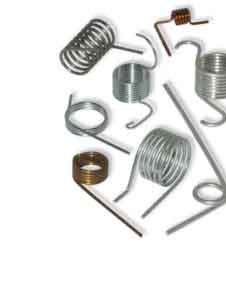Products
 Torsion Spring Overview
Torsion Spring Overview
India Spring Parts offers a selection of torsion springs with legs of equal length oriented at varying unloaded angles. Torsion springs can store and release angular energy or statically hold a mechanism in place by deflecting the legs about the body centerline axis. They offer resistance to twist or rotationally applied force. A spring of this type will reduce in body diameter and increase slightly in body length when deflected in the preferred direction of the fabricated wind. Depending on the application, torsion springs can be designed to work in a clockwise or counter-clockwise rotation, thus determining the direction of the wind. Common torsion springs are those used in a clothes pin or a garage door.
Torsion Springs Characteristics
India Spring Parts offers a selection of torsion springs with legs of equal length oriented at varying unloaded angles. The torsion spring configuration is created for the purpose of storing and releasing angular energy or for the purpose of statically holding a mechanism in place by deflecting the legs about the body centerline axis. A spring of this type will reduce in body diamter and increase slightly in body length when deflected in the preferred direction of the fabricated wind.
The direction of the fabricated wind can also be important for torsion spring applications due to the leg bearing/attachment location having to be on the left or right side upon assembly.
A torsion spring is normally supported by a rod (mandrel) that is coincident with the theoretical hingeline of the final product.
Torsion Spring Dimensions
 Hold the spring in one hand, and the calipers in the other hand.
Hold the spring in one hand, and the calipers in the other hand.- Place the caliper “teeth” on the inside diameter. This is called the Inside Diameter (I.D.).
- Place the calipers on the “leg” to measure the wire. This is called Material Size (or Wire Diameter).
- Place the calipers on the working coils of the spring. This is called the Body Length.Place the calipers on the working coils of the spring. This is called the Body Length.
- Count the total coils, beginning at one end, just under where the leg leaves the body. Count to the other end, all full coils, and any fraction thereof. This is called Number of Coils and determines leg position. i.e. 90°, 180°, etc.
- Determine the direction of coil (Wind Direction). See diagram for hand/finger illustration. Right Hand Wind or Left Hand Wind.
Materials
The highest grades of spring wire are used when fabricating our torsion springs. To create cost-effective warehousing of our stock spring inventory for our customers, we offer material certification for custom springs only. Certifications of conformance for geometric tolerances set by the Spring Manufacturers Institute (SMI) are available for stock torsion springs upon request.
The term “spring steel” is a stock inventory term covering music wire, hard-drawn(MB) wire and oil-tempered wire. Additionally, stock torsion spring materials may include 300 series stainless steel.
Tolerances
Tolerance values for torsion springs depend on the body-diameter to wire-diameter ratio and are about +/- 10% in torque and +/- 5% in diameter.
Finish
Our stock torsion springs come in a selection of commonly requested finishes:
- Zinc
- Gold Irridite
- Passivated (upon request)
- None (can be plated upon request)
